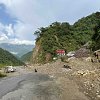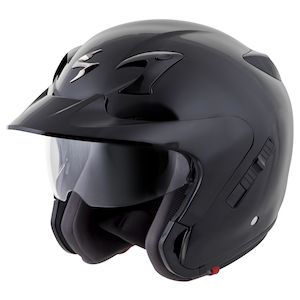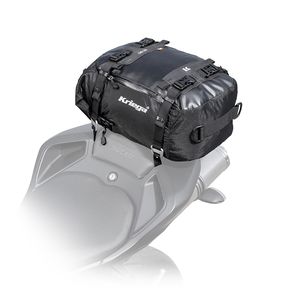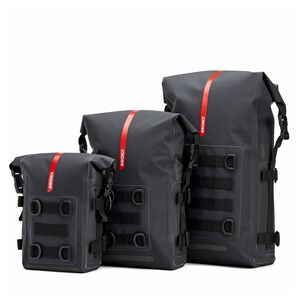There are more than 1.4 billion people in India, but as we rode our motorcycles along the narrow strip of pavement that would become the highest road in the world, we were alone.
As we climbed, the air gradually thinned and soon the weather soured. Dark clouds swirled through the nearby peaks and cold wind whipped at our faces. High above the treeline, the surrounding slopes were barren and rocky, no snow to dance in the currents or forests to wave and sigh in the wind. The mountains stood stoically while man-made things like prayer flags and road signs flapped and swayed in sharp gusts of alpine air.
Team CTXP this time consisted of Spurgeon and myself, along with Spenser and a small video crew. Our machines were Triumph’s new Speed 400 and Scrambler 400 X, and their reaction to climbing above 17,000 feet was largely the same as ours — breathing hard and feeling weak. We were closing in on the summit of an ultimate test for Triumph’s new Bajaj-built 398 cc singles, neither one really made for cross-country travel and each of them carrying at least 200 pounds of American adventurer.

Behind us was nearly a week of riding from Delhi, and it felt like each mile had its own story to tell. We had survived an overnight traffic jam, crossed countless streams tumbling over the road, ridden under the arms of excavators in the middle of work, and watched the streets of a city become a river. All in the name of getting to Umling La, the highest motorable pass on the planet. And, of course, making the video below.
As epic as our destination was, the journey was the whole point, as usual, and India was very much the rule, not the exception to that old adage. First of all, it’s far away. Just getting ourselves from Los Angeles (and Philadelphia) to the humid blast of air stepping out of Indira Gandhi International Airport was a test all on its own. But that’s Spurgeon’s story.
The paradox of Indian traffic
We had one hurdle to clear that was more serious than visa or passport issues and more unfamiliar than splashing across a washed-out road — traffic etiquette. Exactly what is so intimidating about riding a motorcycle in India is hard to say, because it’s made up of so many little things. It's like trying to explain which part of a diamond sparkles.

It was not my first time in Delhi, and so the taxi ride from the airport reminded me of the chaos of crowded Indian roads. Spurgeon, on the other hand, is normally swaddled in the velvet cocoon of Pennsylvania, where practically everyone uses a horse-drawn carriage. Watching an Uber driver calmly weave and honk his way across the sprawl of 30 million people was impressive, but not confidence inspiring.
After a day or so of preparing the bikes and packing the crew car, we headed north into and through New Delhi, and onto a segment of the epic National Highway 44 that connects Delhi to the population of Chandigarh, about 150 miles away. It was early on a Sunday morning when we left, and quieter than usual.

Some combination of pollution and humidity made the atmosphere hazy and translucent, hanging over the city and diffusing the sunrise into a dull glow that slowly brightened as the teeming pool of humanity came to life. Traffic was light, but it’s not the number of cars on the road that’ll fray an American rider’s nerves, y’see, it’s how they all interact. Everyone driving on the left side of the road (the wrong side, to us ‘Mericans) is the least shocking piece of it all.
One of the hardest things to get used to is how many different vehicles make up the traffic — along with motorcycles, cars, vans, and semi trucks there are tractors, auto-rickshaws (tuk tuks, to some), every kind of pedal-powered contraption, scooters, people in wheelchairs, pedestrians, dogs, and just about any other mode of transportation you can imagine. Rather than small vehicles using smaller roads, everyone shares the largest road — for the simple reason, I assume, that it’s the best way to get from A to B.
General etiquette of the road also took some getting used to for us westerners. There are lanes painted on the road but they’re not even taken as a suggestion, much less used as a guideline. People go where it seems to make the most sense for them, and the traffic behind is left to sort it out. Turn signal usage is surprisingly high, though it wasn’t always clear that it meant what I thought it meant. Traffic signals are rare and stop signs don’t really mean anything. Speed bumps and common sense rule the roads.

Sometimes closing speeds are very high, and the combination of different vehicles is staggering. Imagine a massive diesel truck moving around a 12-foot long tricycle full of cargo, which is passing a sedan that is inexplicably parked in the slow lane, as a school bus passes the truck and two SUVs pass the school bus, all while a family walks slowly across the road in front of all of the vehicles.

As insane and chaotic as it seems, not once did I see anyone who seemed to be upset with someone else. Everyone goes through the motions and seems to understand what the other is trying to do. There’s essentially no indignance or entitlement, even if people are clearly in the way of others. Drivers and riders honk incessantly, mostly to let other vehicles know where they are, but it seems like there is rarely aggravation. It’s mayhem with a Mona Lisa smile.
On the face of it, a foreigner riding a motorcycle out into one of the busiest traffic corridors in India is like riding into a meat grinder of white Maruti Suzukis and Eicher 10-wheelers. From another perspective, though, it’s amazing and refreshing to interact with other drivers, in such a direct way and with virtually no anger whatsoever. In either case, quite a rush.
The road most traveled
In Chandigarh, we were hit by a bruising rainstorm which, as the CTXP episode showed, caused some predictable dampness and some fairly unpredictable damage to our route. As we continued north toward the Himalayas, the traffic mellowed, but another curveball came our way in the form of the actual road surface. Which is to say, sometimes there was no road. This manifested in different ways.

We learned that it’s perfectly normal to see part of a road missing in one way or another. Sometimes one lane would be eroded away completely, leaving a serrated edge of pavement with nothing but the river or cliff below. Many times each day we approached a stream, or a gorge, or some other relief in the earth’s surface that had no bridge across — the road simply dipped off its course and degraded into a makeshift path through the terrain, then rejoined on the other side.

Because of (and despite) the rain, there is also road construction happening constantly. The aforementioned half bridges were often being built, plus there were paving projects, guardrail installations, and sometimes simply debris being moved. That meant being ready for piles of gravel blocking the most obvious path, people lining the side of the road, or riding under the arm of an excavator or backhoe.

At one point, after surviving yet another deluge of rain, we came around a corner to find a flood of garbage scattered across our path (for clarity, it does take a lot of garbage on the road in India for it to stand out). A few hundred yards later we saw the inlet to a narrow hollow, evidently being used as a landfill, which had overflowed with water and vomited out enough trash to practically block the road.

All of this is to say nothing of the animals in the road. Being sacred to much of the Indian population, cows are very common and rarely behind a fence. To be fair, every one we ever saw in the middle of a road appeared to be extremely well conditioned to traffic, whether in the center of a city or on a deserted highway. They didn’t seem to care if the vehicle was honking, speeding, or nearly hitting them. Probably because they’re used to being looked after by the general public. Inconvenient, but at least a little heartwarming.

Eventually we left the busier state of Himachal Pradesh and entered Ladakh, the last patch of land before the seam connecting the Indian subcontinent and Asia itself. Road construction continued everywhere, but the surfaces in general improved hugely. The math seems pretty simple — fewer people, less traffic, better roads — but the infrastructure in parts of Ladakh is also strengthened by a massive military presence, due to the looming border with China.
New bikes, old adventure
Good roads or bad roads, sunshine or rain, our new baby Triumphs soldiered on. This ride served as a bizarre test for $5,000 motorcycles that are meant to be an entry to the pastime, not tools to check a bucket-list adventure off the list. But, anyone who saw the CTXP team ride across Alaska, Wyoming, or Colorado knows that our philosophy has always been clear — the wrong tool for the job often makes for the right kind of adventure.

Then again, having seen some of the challenges that India and Indian roads can provide, this was arguably an ideal dress rehearsal. Any motorcycle manufactured and sold in India ought to be able to cope, and if it can, there isn’t much that will stop it anywhere else in the world. Let’s not forget that throughout the ages of motorcycling, and all around the world, single-cylinder machines have succeeded again and again. If any market knows that, it’s India.
It’s tempting to try to spew out every last thing we learned about these all-new Triumphs over the course of nearly 2,000 miles in the saddle, but that’s (literally) another story. One that we’ll tell as soon as we can.

The big takeaway that we felt from these bikes was the pure willingness that every motorcycle in this category should deliver. A yes machine. Playful, but not too powerful. Substantial, without being intimidating. They were not made for this scale of adventure, but they galloped and meandered through one of the most famous mountain ranges in the world without missing a beat.
Eventually, we stood atop the spine of earth separating the world’s two most populous countries. More than a billion people on either side of the line, and not a soul in sight. We spent a few minutes taking in the highest road in the world, being pelted by mid-August sleet, and wondered what the return trip would bring.































 Riders Plus Membership
Riders Plus Membership























